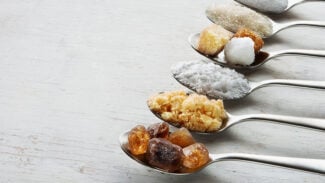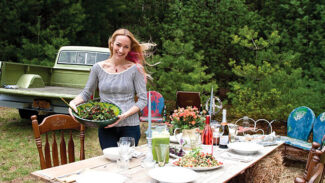Hey Sweetness,
Are you afraid of bananas? I don’t mean literally, of course—but do you avoid higher-sugar fruits because you think they’re “bad” for you? This is something I want to discuss today.
Sugar is tricky. And in general, we should keep our sugar intake low. Like most things that affect our health, though, it’s more complicated than that. Some health advocates aren’t acknowledging this, and are pushing a more black-and-white approach. I think telling the whole, detailed story is more helpful.
In this blog, I’ll cover my personal sugar story, the nuances of various types of sugar and how to reduce sugar in recipes. I’ll also outline what I believe is a healthy—physically, mentally and emotionally—approach to sugar. At the end of the day, it doesn’t have to be all or nothing and it really comes down to what works for you.
My sugar story
Way back in the day, I used to joke that I had a threesome every night with two guys named Ben and Jerry. In other words, ice cream (and all forms of sugar for that matter) were seriously seductive and addictive to me. I struggled through this rollercoaster relationship for years. Let me paint the painful picture for you: Most nights, I’d open up a fresh pint of ice cream and promise myself I’d have just a bite or two (hello, amnesia!). But then I’d quickly realize that I couldn’t put the spoon down. How did I stop? I’d use my dessert as my ash tray… Except that wasn’t enough—I’d just dig out the cigarette butt and ashes and keep going. Next (desperate) step? I’d spray it all down with cleaning supplies. That would finally stop me. Talk about dysfunction.
I tell you this to illustrate that I fully understand the power sugar can have over us. And as a nation, our sugar consumption has gotten completely out of control. Thankfully I have a new, healthier relationship with sugar now (and I kicked cigarettes to the curb a long time ago, too). I’ll nibble on some fruit or vegan dark chocolate when I want something sweet these days. Sugar isn’t the boss. I am. By changing my diet, resetting my tastebuds and dealing with the emotional stuff (important!), I was able to put sugar in its place. I’d say what helped me ditch the sweet stuff the most, though, was educating myself on all things sugar.
Not all sugar is created equal
One response to the sugar epidemic is to deem all sugars off-limits, but there’s a big difference between natural sugars and added sugars. The reason that government agencies and health experts make a point of discouraging “added sugars” is because these types of sugars are heavily processed and devoid of any natural nutrients. They bring our blood sugar up without supplying our bodies with anything healthful: a lose-lose situation.
Naturally occurring sugars, on the other hand—I’m talking about the sugars in fresh fruits and vegetables—deliver sweetness while also providing vitamins, minerals, antioxidants and concentrated stores of powerhouse phytonutrients. The sugars in fruit (or sweeter vegetables, like carrots, beets and sweet potatoes) also come packaged with fiber, which helps us feel full and slows the absorption of sugar into our bloodstream. Plus, the micronutrients in fresh fruit may prevent the uptake of sugar in our small intestine. This means that many of us can enjoy the delightful sweetness and health benefits of fresh fruit without experiencing the drawbacks of mood-busting highs and lows and blood sugar spikes.
Not surprisingly, evidence shows that populations who eat more fruit have a lower BMI and lower risk of developing many chronic diseases, including high blood pressure, heart disease, stroke, certain cancers, type II diabetes, digestive diseases and obesity.
A sane approach to sugar
A healthy relationship with sugar is different for everyone. If you have special reason to be vigilant about the amount of sugar in your diet—for example, if you’re a cancer patient, or have diabetes or candida—then you may want to exercise some mindfulness even with naturally occurring sugars. For you, it may be wise to seek out fruits that are lower in sugar, and to use only moderate amounts of fruit and sweet veggies in your green drinks and meals. Avoiding refined and processed sugary treats as much as possible is a no-brainer when facing these challenges.
For those who need to swear off the sweet stuff, don’t despair. It’s possible to create tons of flavor and character in recipes without relying exclusively on sweet ingredients. One of my favorite tricks for brightening the taste of my juices and smoothies is to use fresh herbs, lemon, lime and ginger. Just because your juice or smoothie isn’t sweet, doesn’t mean it should be blah.
But for many people, I advocate finding some middle ground in the sugar struggle. A dogmatic approach of total avoidance—including naturally occurring sugars in produce—can lead to rebellion and bingeing (see: Ben & Jerry’s story). Not to mention all the missed out benefits that come from something as remarkable as a blueberry. Keeping sugar in check should not be about vilifying it or fearing it. It should be about making peace with it, living comfortably with it and understanding how much sugar feels good to each of us as individuals. The aforementioned banana could be a no-no for some, but could be hugely healthful for others. It’s up to each of us to determine how much sugar is right for our bodies and lifestyles.











I’m SO glad you covered this issue!! I lead a cleanse every January called the New Year (R)evolution, and understanding the difference between natural and refined sugars is always a hot topic. I’m sharing your blog with my cleanse group right now. Thank you for laying it out for us!
Thanks for sharing! 🙂 kc
Here is my background I have lymes, and a possible stage 0 breast cancer. I enjoy a cup of my very favorite cup of Chinese black tea every morning. I prefer it will a little cream and one teaspoon of sugar. I can and I have gone with out the teaspoon of sugar and I really prefer it just a little sweet. Any suggestions on how to do this and keep the taste as close to old fashion white sugar as possible?. I follow an Ayurveda diet mostly so honey is not an option as we consider heating honey not beneficial to the body. I can go with out the black tea I can go with out this teaspoon of sugar and I am looking for a healthy sweetener alternative. I agree with your philosophies and I am clear on the emotional spiritual value of a positive relationship with my healing and my food. this is why I am adding back my one cup of tea in the morning as it brings me much joy!
I use Stevia in my coffee/tea. I have heard that is better for the body than sugar, splenda, or honey. I use Agave to sweeten my smoothies and as a syrup on my whole grain pancakes.
Have you looked into Just like Sugar, it is made from chicory root, 0 sugar. I tried several different natural sugar alternatives and this one works for me and I like the taste. Best place I have found to get it is Vitacost.com. Hope this helps. You can use it any way you would use sugar, they also have a brown sugar, powdered and a good hot chocolate mix (my comfort drink).
Hi Sybil,
There’s a great naturally sweet tea called Amacha (Japanese herbal infusion) that has a taste somewhere between honey and liquorice. It’s delicious and contains no sugar. I personally don’t like stevia so much as I find it leaves a strange aftertaste. So if that’s your case too and you want to avoid sugar completely, I’d suggest Amacha. As it’s tea it’s prepared hot anyways so it fits well in other teas. iit even has some traditionally recognised health benefits (anti-allergic and helps with high blood pressure). You can find it here: http://www.momochafineteas.com/Teas/herbal-tea/amacha-15g
Hope this helps! x
Hi Sybil,
It is my understanding that in Ayurveda the honey is not to be heated but can be added to hot tea. I boil my water, add to tea, then add almond milk, then lastly honey.
Hi Sybil, I think my other blog on sugar may be helpful in exploring some other sweet options. Check it out here: http://bit.ly/1OKlrLv xo, kc
Have you heard of Lakanto?
It is a healthy 0 calories and 0 glacemic index sugar substitute.
Tastes just like brown sugar and has health benefits.
Here it is on Amazon:
http://www.amazon.com/gp/product/B0079OL6T4?psc=1&redirect=true&ref_=oh_aui_detailpage_o01_s00
Good luck!
I was gonna say stevia as well. Did you know it helps destroying the mucussy stuff in which the young lyme bacteria develops? I also have lyme and follow the main rules of ayurveda lifestyle. I have stopped though being very strict for great reasons. I would use honey, maple sirup, coconut sugar, stevia or regular organic cane sugar (but just a little). As you see, I slacked on the avoiding sugar at all cost regiment. Lyme healing is a long process and one must trust it, if you listen to yur self. I believe it is highly spiritual. I know I’m towards the end. I wish you the best!
Oh, I just wanna add, when we crave sugar sometimes, it is because we lack of carbohydrates that is found in fruits.. The craving disappear gracefully just when eating fruits.
Cheers!
To your plates! (of fruits)
one or two drops of pure stevia extract is a perfect sweetness for tea.
I like this balanced approach. I cut out all sugars for a week but kept eating fruit and veg so took in sugars that way – I felt great, lost some weight, gained energy but I cannot sustain it in the long term. I try to be wheat-free but similarly, it is difficult to be zero-wheat every single day. I have similar experiences to your Ben and Jerry ice-cream where I have eaten artificially sweetened, high calorie rubbish to excess as if I have no willpower to stop. Thinking about what I eat in a mindful way must be the way forward but life has to be for living too! Refusing a piece of birthday cake offered to you by a four-year old? Nah!Everything in moderation.
What do you think of stevia, xylitol, etc??? There seems to be a lot of varying opinions out there…… You posted a recipe for this caramel apple tart that had no added sugar in it and it was amazing!!! Even better with some cocount cream on it!
Stevia does not taste natural to me at all. It has a chemical taste to me and I want to like so bad. If I am baking, sometime I use coconut nectar and love that.
Try (green) whole leaf stevia leaves and powder ’em. Tastes SO much better than the processed stevia found on the store shelves. (Extracts that are clear and powders that are white are processed which is where the chemical aftertaste comes from)
The powdered stevia leaves in its natural form do not dissolve as it’s chemically extracted counter part does, but I don’t mind knowing it’s in a natural form. Hope that helps!
usually that weird bitterness means youre using way too much, use about a fourth of what you normally would with sugar – hope that helps!
Since January I have been struggling with new food allergies all of a sudden. It started with fish (after I have eaten fish my whole life) and now seems to be sporadic. Doctors think I may have a mast cell disorder in which my mast cells randomly release too much histamine at once, wrecking havoc on my body and causing anaphylaxis. They have me taking 5 antihistamines daily (and sometimes more) but it has also caused quite a bit of anxiety for me. I would love to meet with a holistic doctor to figure it out, and eliminate the drugs. I hate pills, but I hate anaphylaxis more! LOL I try to eat very healthy, lots of juices, lots of veggies… but have severely restricted my foods in an effort to eat lower histamine foods. Would anyone have any suggestions, or doctors you recommend? I live in upstate NY..but am willing to travel.
That was supposed to say since July…not January
Jen, please go to Yasmina Ykelenstam’s website and you will be rewarded with a plethora of information regarding histamine intolerance. She is your gal.
Hi Jen,
Did you move or changed environment in some way (work place etc.)? Might be any extra toxicity (not just in your food) that is stressing your body out so it doesn’t cope well with allergens anymore? I believe detoxing helps with allergies a lot. Just a thought, hope it helps. X
Hi Jen,
You may want to research an allergy elimination technique called NAET-link to website https://www.naet.com/Patients/patientshome.aspx It has really been helpful to me and others I know. They test for over 1,000 possible allergies and clear them usually through acupuncture. Good Luck.
Jeannie
Try looking into BIE ( http://www.bieclinics.com) i believe there are some practitioners in the US, although the training takes place in Canada. It can help balance the mast cells and other things!
Hi Jen!
Have you seen the documentary “Fat, Sick, and Nearly Dead”? The man in the film has a condition that sounds pretty similar to what you mentioned! You can find it on Netflix!
Best,
Kelly
I have to add to this, that I have mast cell activation also and the same Autoimmune Urticaria that Joe from Fat Sick Nearly Dead, has, only I was Thin Sick and Nearly Dead. 🙂 Autoimmune Urticaria for me was happened because the mast cell disorder had been untreated so my body created autoantibodies to attack the mast cells, but yet have no skin conditions like Joe, mine is more internal and on my organs. Reading Kris’s Crazy Sexy Diet was my food bible, although I found out I can’t eat a lot of the foods she does, because of high histamines, it was very very informative and helped me a lot!!!!! It helped me to know what to eliminate on top of the histamine foods.
Please find a good NAED doctor.
They eliminate allergies to anything!
I just went thru a series of 15 treatments that eliminated or diminished most of my allergies.
They should remove not only the allergy to the specific allergen, but also an emotional blocks that cause allergies.
Here is a website to the NAED doctor I used, she was excellent, and I did it over the phone (I am in NY she is based in Utah but treats at a distance:
http://www.inharmonyhealing.org/
Good luck!
It is my understanding that if you do have a mast cell activation disorder triggers are histamine rich foods. Fish is high in histamines and the amount increases the longer after the fish is caught. There are many other foods that fit this category to avoid. A good Gastroenterologist or immunologist can help with blood testing and a good ND can help you with diet and supplements to help.
Hi Jen,
I have the same mass cell issues and have dropped all of my many antihistamines by seeing a ND. We do a lot of Vitamin IV therapy and it has been more helpful than the meds. A low histamine diet help too.
Good luck!!
Jen, I have had mast cell disorder for over 9 years and was 80% bed bound. I have a better quality of life, but still very ill, but somedays I do better than others. Changing my diet has been key, along with things as easy as getting rid of plants in the house, and toxic household cleaners, and staying in doors during pollen season. I don’t want to cut in on Kris’s blog, but if you have any questions feel free to contact me. Not sure how I can post that on here without having my email so public?
There’s no need discard the nut pulp – almonds are expensive. It’s loaded with fibre and is great for adding back into smoothies, or naturally sweetened gluten free muffins or brownies.
Great idea….I will do that…thanks
Yay! Sugar free is the best. Really cleared up my skin. I have hot chocolates made with stevia and almond milk as a treat.
Kris, my daughter bought me CRAZY SEXY KITCHEN about three years ago. I follow your regime closely. I have all of your books, including the new juice book. As a fellow survivor, I know you do diligence in your research. Thank you and HAPPY NEW YEAR!
Happy new year, Minnie! xo
Thanks so much for this Kris! There’s so much controversy about sugar. I’ve managed to more or less fully ditch processed sugar over the last year (only have it as cookies or some choc for holidays) and I mostly don’t miss it at all as there’s so many good alternatives that taste so much better than sugary stuff! Your chocolate almond milk is SO delicious too!! Love LOVE your CrazySexyJuice book, ALL the recipes are absolutely fantastic, it’s incredible you could come up with so many so outstanding ones! 🙂 You’re so creative and inspiring. Really made my year with it, I’ve been juicing and blending daily ever since the book came in October 😀 Keep up the great work you do and a very happy New Year from London! Xx
That’s phenomenal, Mojca. You made my day! xo, kc
So timely! I just kicked off a 10 Day Sugar Detox with a group of clients. I have A LOT of questions about why I am ‘allowing’ them to eat fruits and starchy vegetables, even whole grains, lentils, and beans. Your post today says it all!! I so incredibly happy to have you on my side, fighting the good fight! You have make learning THE TRUTH about nutrition fun and easy! Thanks Kris! I’ll be sharing!
and… I can’t proofread but hopefully you catch my meaning! 😉
Thanks, Jess! So happy to hear this blog resonated with you. Good luck with your detox crew. 🙂
I do have candida problem and have to be very careful with even sugar in high sugar fruit like bananas or dates.
3 things I rely on for sweet taste are:
Stevia (great in smooties, kefir and yogurt)
Xilitol (in small amounts as it might cause stomach upset)
Lacanto (zero calorie zero glacemic index superfood made of a monk fruit and Erithrol)
You can bake with all 3 but Lakanto tastes and bakes just like brown sugar and has health benefits.
I use it in my coffee and tea and as an over-all sugar substitute.
It costs a bit more, but it sure it worth it!
Sorry for the typos and I love your blog Kris, you are an inspiration to me!
Thank you Kris. Your energy and wisdom is so inspiring for everyone. I started following you after being diagnosed with recurrent breast CA. I forward all of your emails to all of my friends who have an interest in living a really healthy life. I look forward to every communication and the interaction from other followers.
Happy New Year!!
Namaste!!
That’s so wonderful to hear, Janeen. Thank you! 🙂 kc
Thank you for this Kris. The last time that we met I asked you about sugar! I am so fearful of it, living with cancer, and yet… When you have issues with food and you’re diagnosed with cancer, at least for me, it’s not like all of my issues just magically disappeared. I still find comfort in a cupcake from time to time. I still crave soda (though went from drinking it daily to probably having 3 glasses a year). I’ve always struggled with my weight (mostly carbs, also living with PCOS) and though I’ve made some great changes, I’m still scared when a recipe calls for 2 bananas in my smoothie; will my cancer grow? If I have a piece of pie on Thanksgiving, will cancer take over my body? I know that I have to find what I’m comfortable with– that will be the right answer for me– but 2 + years into the diagnosis and I still struggle with it and feel guilty and worried and scared. I appreciate you reminding us that we each need to find our own way with this. You remain a true source of support, wisdom and strength for me and many others. xo.
Great read! I avoid processed sugar. If it is all natural, I enjoy it freely!
I definitely have a sweet tooth and find that even if I try just ONE piece, I’m always craving more–AKA I’m addicted. I’ve tried to keep this “healthy” by using mints and gum, but I’ve realized this still fuels cravings. Coming to terms with the fact that just one piece still does damage is rough, but necessary–hoping to kick the habit in 2016!
I watched my mother try to solve her problem with chronic low energy and then develop adult onset asthma and painful arthritis in her early fifties. Then she read a little article about the inflammatory properties of sugars in the then new little health magazine, Prevention. She experimented with eliminating added sugars and eating only lower glycemic fruits and felt a positive change in days. In three months her asthma and arthritis were gone and her energy so improved she went back to school and got her master’s degree! She was so amazed she started informally studying all things nutrition. She died last year at 97 1/2, taking only one minor med for pain from post polio syndrome (she had polio in her thirties). In my early thirties I started to get some arthritis in my wrists. I followed her lead and 40 years later at 73, I still have no arthritis and take only one med, thyroid. I’ve learned over the years that my best diet is what might now be called Pegan–animal proteins (pastured, organic, humanely cared for), and otherwise vegan–I have tried to be a vegetarian twice in a conscientious, educated away and became terribly anemic, both protein anemic and hemoglobin anemic–some people can’t), tons of veggies, nuts, seeds, low glycemic fruits, no grains, no beans; Like my mom, I have a poor sugar and starch carbohydrate metabolism. I’m convinced after years of studying every nutrition angle I could find that the key to wellness is eating real, whole and preferably organic food, and figuring out the balances that best serve one’s bio-individuality. Love Chris Karr, her spark of life and wonderful wisdom.
Thanks Annie! x
I loved Annie’s story about her mom also. That is inspiring about you and your mother. I hope my results are as good as yours at the three month mark. I have had some improvement, but it’s only been a few weeks. Will keep hoping for more improvements. And forgot to thank Kris for the great article. 🙂
Maiysa
Back in the day when I was on a tear with some sweet treat and couldn’t stop eating it I’d put it in the kitty litter! or in soapy dish water!! That would stop me. Now I satisfy my sweet tooth with xylitol, which is actually good for your teeth (and low glycemic). I also make a nutrient dense sweet treat with 1 T (tablespoon) of coconut oil, one T mashed banana, one T cacao, half T of hemp powder, half T chia seeds, half T of almond butter, one T of chopped walnuts: I blend it all together and put in the freezer for about 15 minutes. It is delish!
Sounds delicious. Thank you.
I have been making the above mentioned recipe for some time and love it as is without straining it through cheesecloth or a nutmilk bag. Is there anything wrong with that?
Hi Kris, you often write just about the issue I am solving at the time. I have been thinking of the most important things over the past year. Here they are: 1.Neville Goddard teachings, 2.Kris Carr, 3.Matrix Energetics. I spent almost all Christmas holiday with my nose in CSJ, CSD and CSK (the last one came just before Christmas). I do appreciate your concern about the animal and planet wellfare which is not so common even in people who care about their health. Thank you for being who you are. Tons of love from moi and my animals
Thanks for your informative article Kris – I too am dealing with cancer and have been since last October. Currently I am on chemotherapy and have been working on awareness in my diet – thanks to your amazing efforts and also my loyal and knowledgable sister Tina. For my mental health I try not to stress too much about what I am eating – try to eat as much organic food as I can afford and drink about 25 ounces of green juice daily (made up of mostly organic ingredients) – which by the way makes it possible for me to have NO SIDE EFFECTS (!) from the chemo. I am trying to change one small thing a week instead of doing it all at once.
I am so glad that you addressed sugar today in your blog – as well as sharing your candid experience of your struggles with it – as sugar is a subject I have had some questions about. What I find so interesting is that of all of the doctors I have seen, not one has mentioned anything about diet – certainly not one has mentioned sugar and avoiding it if you have cancer – though they certainly make use of it when giving a PET scan – “The positron emission tomography (PET) scan creates computerized images of chemical changes, such as sugar metabolism, that take place in tissue. Typically, the patient is given an injection of a substance that consists of a combination of a sugar and a small amount of radioactively labeled sugar. The radioactive sugar can help in locating a tumor, because cancer cells take up or absorb sugar more avidly than other tissues in the body.” Well, hello – if that isn’t enough to make you want to quit sugar if you have cancer? Or perhaps lay off the sugar if you are eating lots of it?
When the craving for sweet strikes, I usually eat an apple or have some raw cashews. Sometimes – on very rare occasions, I will allow a cookie, or a small piece of pie but generally stay away from all candy, gum, soda, etc. What is great is that the extra pounds have come off!
I would like to add that I am so grateful for all the hard work you have done. It has been a life changer for me. Thanks so very much!